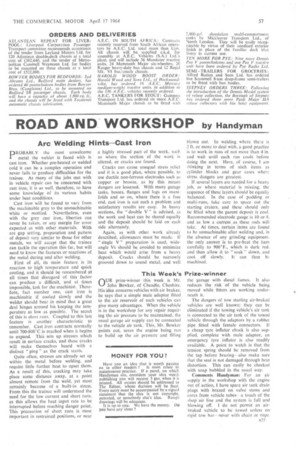ROAD AND WORKSHOP by Handyman
Page 59

If you've noticed an error in this article please click here to report it so we can fix it.
Arc Welding Hints—Cast Iron
PROBABLY the most unwelcome metal the welder is faced with is cast iron. Whether pre-heated or welded cold it can be a complex operation and never fails to produce difficulties for the trainee. As many of the jobs met with in vehicle repair can be concerned with cast iron, it is as well, therefore, to have some knowledge of its various habits under heat conditions.
Cast iron will be found to vary from the machinable grey to the unmachinable white or mottled. Nevertheless, even with the grey cast iron, liberties can never be taken, or any margin for error expected as with other materials. With arc gap setting, preparation and pattern of deposit very similar to those for other metals, we will accept that the trainee can tackle the operation this far, but will need to know the features or reactions of the metal during and after welding.
First of all, its main feature is its reaction to high temperature and quick cooling, and it should be remembered at all times that disregard of this factor can produce a difficult, and at times impossible, task for the machinist. Therefore, fact number one, cast iron is machinable if cooled slowly and the welder should bear in mind that a great deal hinges around his keeping the temperature as low as possible. The secret of this is short runs. Coupled to this last feature is another characteristic to remember. Cast iron contracts normally until 700-800°C is reached when it begins to expand. This sets up stresses which result in surface cracks, and these cracks will make themselves heard with a distinct 66 ping " as the crack starts.
Quite often, stresses are already set op within the metal before welding, and require little further heat to upset them. As a result of this, cracking may take place some distance away, at a point almost remote from the weld, yet most certainly because of a built-in stress. From this the trainee will understand the need for the low current and short runs, as this allows the heat input rate to be interrupted before reaching danger point. This precaution of short runs is most important in restrained positions, or near a highly stressed part of the work, such as where the section of the work altered, or cracks are found.
Cracks can cause unequal stress relict and it is a good plan, where possible, to use ductile non-ferrous electrodes such as copper or bronze, as by this means dangers are lessened. With many garage tasks, bosses, flanges and logs on manifolds and so on, where there is a free end, cast iron is not such a problem and satisfactory results are easy. In heavy sections, the "double V" is advised, as the work and heat can be shared equally and the deposit should be laid on each side alternately.
Again, as with other work already described, allowances must be made. If "single V" preparation is used, wideangle Vs should be avoided to minimize heat which wduld arise from a heavy deposit. Cracks should be narrowly grooved down to sound metal, and well
blown out. In welding where there is 2 ft. or more to deal with, a good practice is to work in runs of not more than 4 in. and wait until each run cools before doing the next. Here, of course, I am thinking in terms of stich items as cylinder blocks and gear cases where stress dangers are greatest.
If several layers are needed for a heavy job, or where material is missing, the sequence of these layers should be equally balanced. In the case of padding or multi-runs, take care to space out the starting craters, and these should only be filled when the parent deposit is cool. Recommended electrode gauge is 10 or 8. and as low a current as these rods will take. At times, certain items are found to be unmachinable after welding and, in the absence of any grinding equipment. the only answer is to pre-heat the item carefully to 900°F., which is dark red. and then allow it to " soak " down, and cool off slowly. It can then
machined,




































































































































